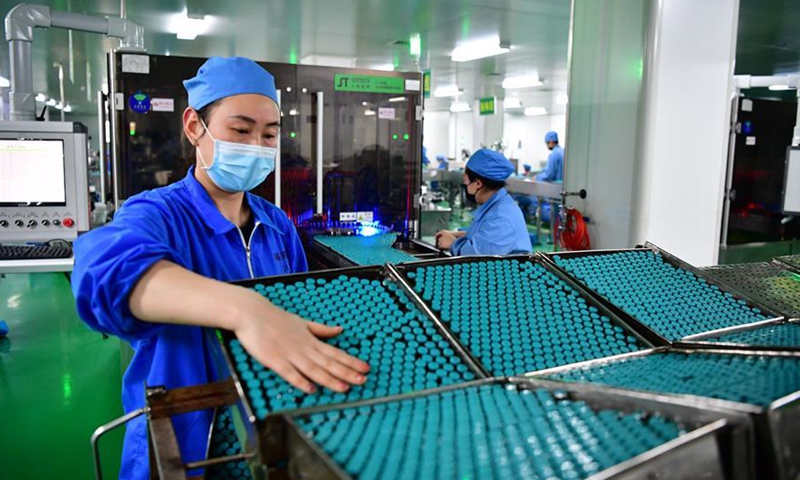Factories in China tackle sweet pain of labor shortage
By GT staff reporters Source: Global Times Published: 2020/10/28 19:38:41
Spike in workers demand signals economy firing on all cylinders

Employees work in a factory of Fusen Pharmaceutical Company in Xichuan County in Nanyang, central China's Henan Province, Feb. 20, 2020. As part of the water source of the middle route of China's south-to-north water diversion project, Xichuan County has made much progress in both ecological protection and poverty alleviation.Photo:Xinhua
The coronavirus-beating Chinese economy is living up to its name as the world's factory, with stellar consumption rebound-induced orders surge prompting manufacturers to tackle the sweet pain of a severe blue-collar worker shortage.
The spike in blue-collar labor demand contrasts with an uneven road to an employment recovery at large, and yet it is seen as reinforcing hopes for an economy firing on all cylinders.
Henglin Home Furnishings, China's biggest furniture exporter based in East China's Zhejiang Province, has raised salaries by 30 percent to fill the surging orders. Starting salaries are now 8,000-10,000 yuan ($1,192-$1,490) per month, a company representative surnamed Quan told the Global Times on Wednesday.
By comparison, fresh university graduates get an average monthly salary of 5,290 yuan in their first job, according to data published in mid-September by job-hunting platform Zhilian Zhaopin.
"We've had a labor shortage since the second quarter, when orders started to surge," Quan said. "At first we wanted to hire experienced workers, but now we are accepting more apprentices to fill the gap."
According to Quan, the factory has about 5,300 workers, but it needs 200 more. Business has expanded by more than 50 percent since the second quarter, thanks to soaring export orders for home offices as people spend more time working from home in the US and Europe.
"We've travelled to as far as [Southwest China's] Yunnan Province and [North China's] Inner Mongolia Autonomous Region to recruit, and we've also hired people from [East China's] Jiangxi and Anhui provinces," Quan said. "In the past, we would get most of our employees locally or from nearby cities."
In another example, a manager surnamed Bao from Longda Printing Textile Co, a textile manufacturer based in East China's Jiangsu Province, told the Global Times on Wednesday that it's tough to get new workers.
The company has only about 300 staff, and Bao said representatives went to Anhui Province trying to find 20 new hires, but to no avail.
"We have raised our pay package by 10 percent to 60,000 yuan per year, a decent sum for blue-collar workers in Wuxi, but it is increasingly difficult to find young people who are willing to work in factories," Bao said.
The forthcoming Singles' Day online shopping festival on November 11, the world's largest e-commerce spree, is exacerbating labor shortages.
The coming Double Eleven has brought a wave of new orders, Bao said, contributing about 30 percent of the company's new domestic orders.
This year, many businesses on Taobao and Tmall are using livestreaming for promotions, meaning that orders will come at the last minute, giving manufacturers much less time to make the products.
"That means we have to get many more workers in a much shorter time than usual, cutting our production time almost by half," Bao said. "Sometimes we need to find part-time workers as well."
The narratives of Quan and Bao offer a convincing account of China's economic rebound that is picking up pace, notably in manufacturing. This sector is a pivotal part of the economy's unrivaled strength that defies the pandemic's disruptions to global supply chains.
Manufacturing demand is seeing an obvious recovery, Lu Aihong, spokesperson for the Ministry of Human Resources and Social Security, said at a press conference on Friday, citing the nation's latest top 100 professions with the biggest employee shortages.
Among the 28 professions that were newly added to the top 100 list for the third quarter, 19 (including instrumentation technicians), or 67.9 percent of the new additions, were related to manufacturing. Five out of 15 professions that reported increasing shortages were directly related to manufacturing, according to Lu.
The dearth of blue-collar workers is in contrast to the uneven recovery of the overall labor market.
The quarterly China Blue-Collar Index is compiled by the China Institute for Employment Research (CIER) of Renmin University of China and the recruitment institute of Chinese classified websitec58.com.
The index hit a record high of 3 for the third quarter, up from the previous quarter's 1.55. It also went up substantially from 1.83 for the third quarter of last year.
This level compared with a more gradual recovery of the entire job market.
Another index measuring the national job market jointly released by the CIER and Zhilian Zhaopin clocked at 1.89 in the third quarter, up from 1.43 in the first quarter and 1.35 for the second quarter. It was still short of 1.92 for the third quarter of 2019.
The uneven recovery, mirroring a challenging yet promising outlook for the world's second-largest economy, suggests a full-blown recovery down the road.
Zhang Yi, an official with the National Bureau of Statistics, wrote in a bylined article posted on the bureau's website earlier in October that the economy's continued rebound and the conspicuous improvement in all indictors during the third quarter laid an important foundation for stable employment. A continued uptick in industrial production and an upturn in the consumption market bode well for an increase in job vacancies, the official wrote.
As Nomura economists put it in a research note sent to the Global Times on Tuesday, "China's recovery remains largely on track."
They maintained their real GDP growth forecast of 5.7 percent year-on-year for the fourth quarter, up from an expansion of 4.9 percent in the third quarter.
Posted in: ECONOMY